The medicinal cannabis market is estimated to be valued at USD 23.93 Bn in 2025 and is expected to reach USD 102.58 Bn by 2032, growing at a compound annual growth rate (CAGR) of 23.1% from 2025 to 2032.
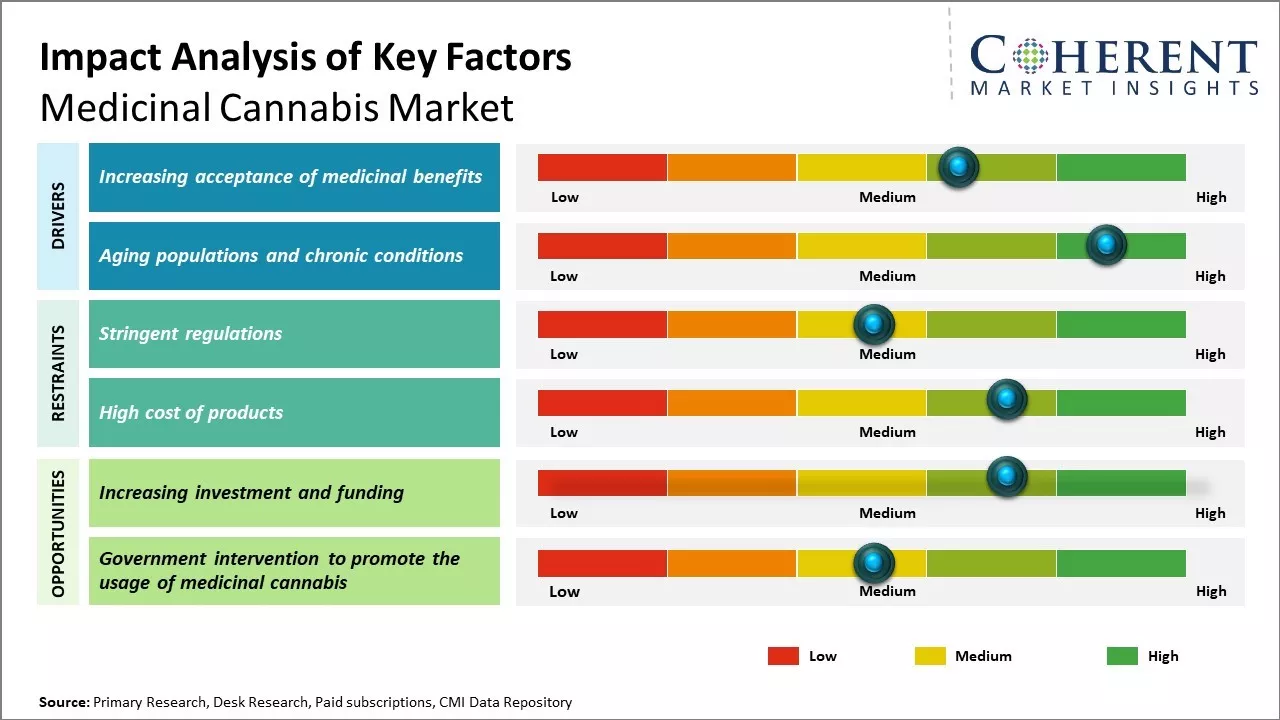
Discover market dynamics shaping the industry: Request sample copy
The medicinal cannabis market has seen significant growth in the last few years. With increasing legalization of cannabis in many countries for medical purposes, and growing acceptance of its health benefits, the demand for medicinal cannabis is expected to steadily rise. Many countries across Europe, North America, and Latin America have already legalized medical cannabis to some extent. With its established uses for reducing chronic pain and illness symptoms like nausea, cannabis is becoming an attractive alternative to conventional pain medicines. Its autoimmune and anti-inflammatory properties are also generating interest for new therapeutic areas. Further research is being conducted to tap its potential against more serious ailments. With an aging population seeking natural remedies and more clinical data supporting cannabis' medicinal uses, this market is positioned for continued expansion.
Increasing Acceptance of Medicinal Benefits
The use of cannabis for medical purposes has steadily gained acceptance in many parts of the world over recent years. This growing legitimization stems from accumulating scientific evidence highlighting the therapeutic properties of certain cannabinoids for a variety of medical conditions. Clinical studies have shown cannabis can help mitigate chronic pain, chemotherapy-induced nausea, epilepsy, and muscle spasms associated with multiple sclerosis. Dozens of countries have enacted regulatory frameworks legalizing access to medical cannabis under a doctor's recommendation, addressing patient demand and providing quality standards.
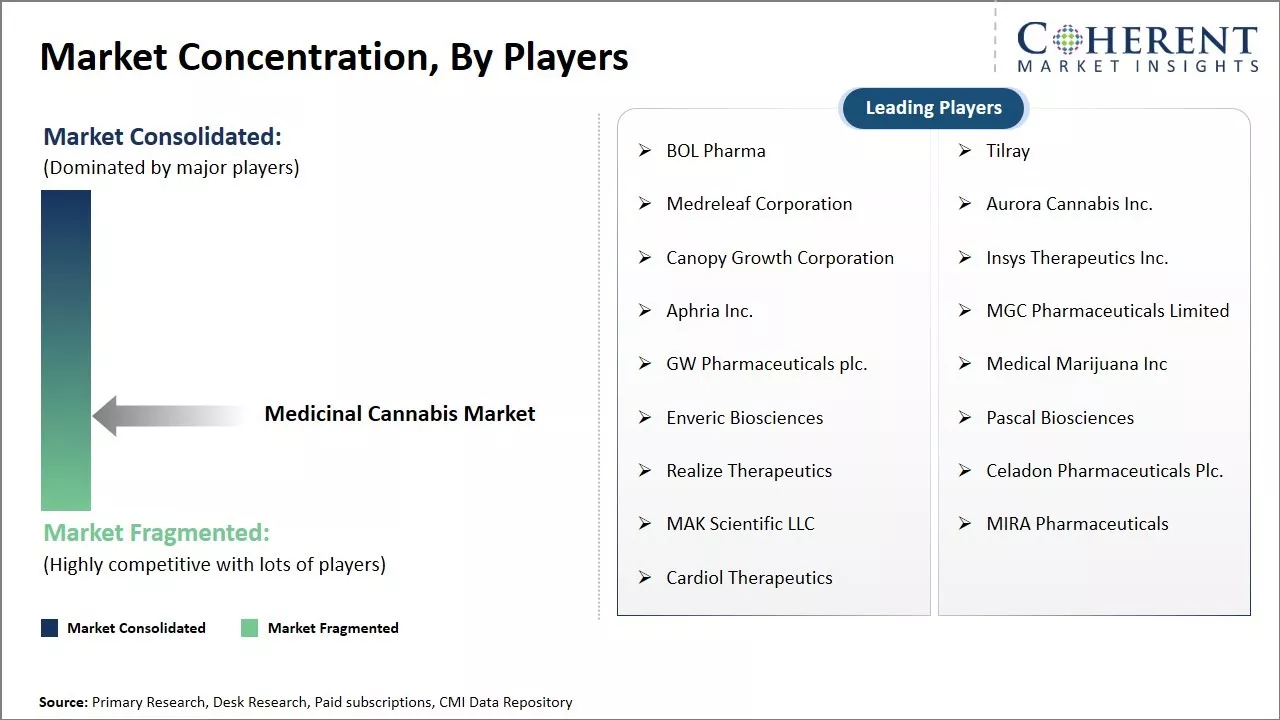
Get actionable strategies to beat competition: Request sample copy
Aging Populations and Chronic Conditions
A confluence of demographic trends bodes well for the medical cannabis market. Advancements in modern medicine have lengthened lifespans worldwide, leading to more elderly populations with age-related health issues. Chronic conditions are becoming more prevalent include arthritis, cancer, and neurodegenerative diseases. Simultaneously, baby boomers born during the postwar period are entering their senior years in large numbers. This generation has proven more open to alternative treatments and active lifestyles later in life compared to previous cohorts. Younger patients are also living longer with conditions like epilepsy, multiple sclerosis, and cancer due to medical innovations - yet standard pharmaceuticals may lose effectiveness or cause intolerable side effects over decades of use. Research into non-addictive medications offers hope. The confluence of these societal trends implies wider acceptance and demand for cannabis as a therapeutic option, especially if its benefits for certain chronic conditions receive definitive scientific validation through ongoing clinical studies.
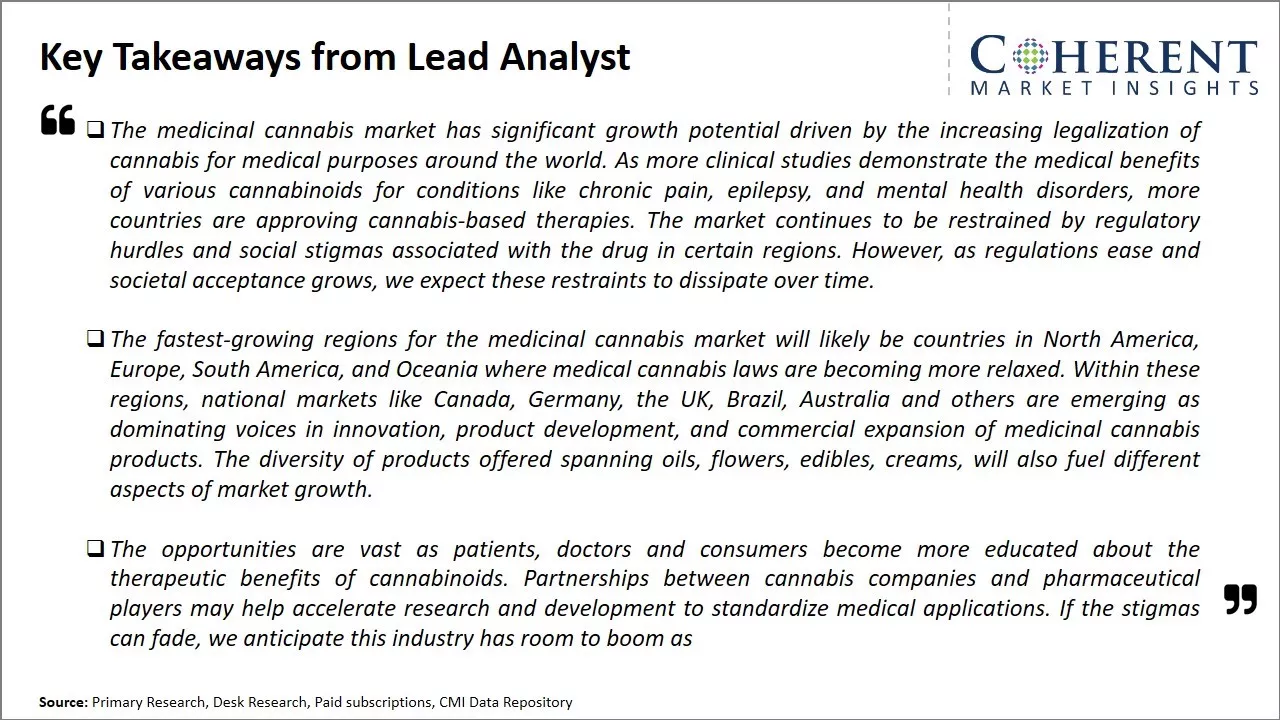
To learn more about this report, Request sample copy
Market Challenges: Stringent regulations
The medicinal cannabis market currently faces several challenges. As the legal status and regulations surrounding cannabis use varies greatly around the world, entering new international markets can be difficult to navigate differing laws. Additionally, further clinical research is still needed to gain widespread medical acceptance and insurance coverage. There is also limited standardized cultivation practices and a shortage of large-scale, low-cost producers which keeps prices high for medical products.
Market Opportunities: Increasing investment and funding
An aging population has created demand for alternative treatments for pain, epilepsy, and other conditions cannabis may help. Public opinion is also becoming more favorable towards legalization as research demonstrates medical benefits. As laws change and scientific evidence grows, the market size is projected to dramatically increase over the next decade. Large investments are pouring in to fund expanded production capacity and research.
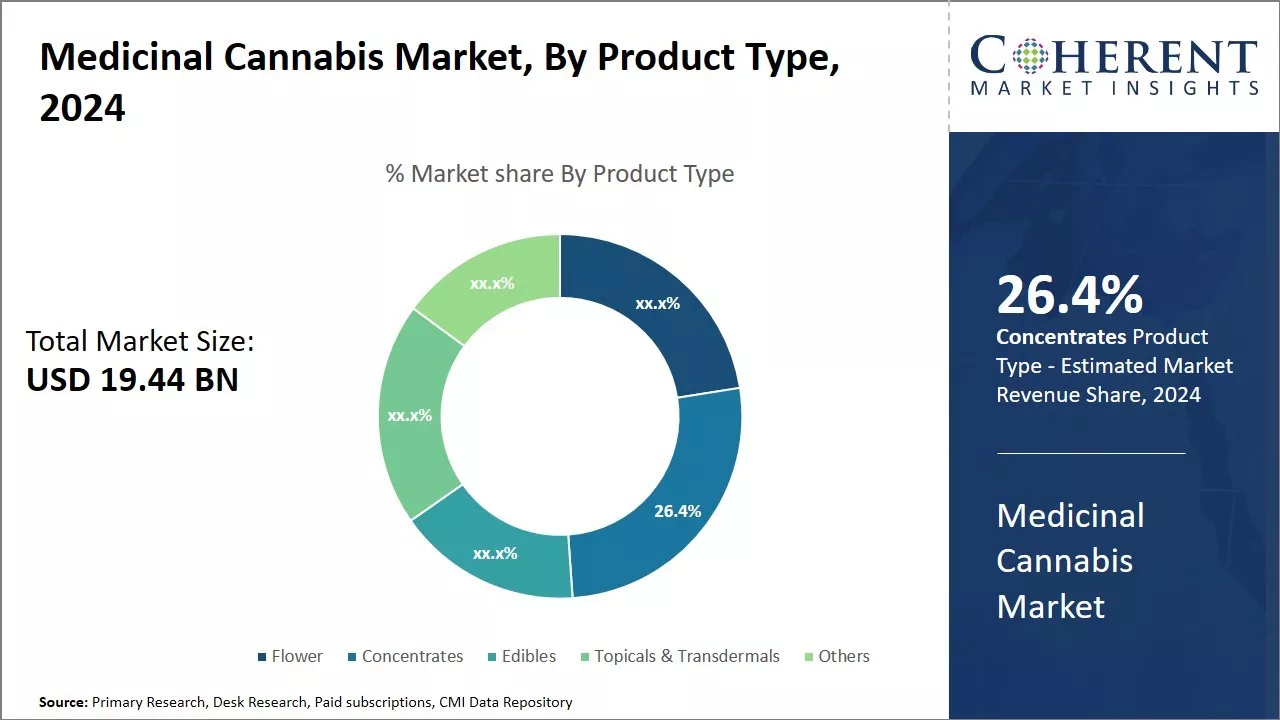
Discover high revenue pocket segments and roadmap to it: Request sample copy
Insights, By Product Type: The growing demand for THC drives the concentrates segment growth
The product type segment includes flower, concentrates, edibles, topicals & transdermals, and others. Concentrates is anticipated to hold 26.9% of the market share in 2025. Concentrates allow patients to consume THC in highly potent forms which are more effective for relieving symptoms of certain conditions. Patients prefer concentrates as they provide a stronger effect from smaller quantities, allowing flexible dosing. Vaporizing concentrates also allows for effective administration without smoking dried flower. New innovative concentrate products such as vape cartridges, edible concentrate infusions are gaining popularity among youth and new medical consumers. Majority of medical cannabis dispensaries now offer a diverse range of concentrate options such as shatter, wax, oils, allowing patients to choose the right form factor. Concentrates have emerged as an affordable and non-smoking alternative to dried flower.
Insights, By Compound: The expanding therapeutic applications of CBD is driving the market growth
The compound segment includes Tetrahydrocannabinol (THC) and cannabidiol (CBD). Tetrahydrocannabinol (THC) contributes the highest share of the market and is expected to hold 57.3% of the market share in 2024. However, the Cannabidiol (CBD) segment is witnessing faster growth owing to its expanding therapeutic applications and legal status. CBD is now recognized for effectively treating inflammation, pain, anxiety and other conditions without the psychoactive effects of THC. This has boosted CBD acceptance among mainstream consumer groups including older adults and families. More number of states have now legalized high-CBD medical and consumer products accepting their safer profile. Due to low THC levels, CBD-dominant products face little regulatory hurdles allowing inter-state trade across the U.S. Rapid research studies exploring new healing properties of CBD are also helping address medical concerns and regulatory barriers.
Insights, By Application: Rising prevalence of chronic pain is driving the demand for medical cannabis
The application segment includes cancer, arthritis, chronic pain, Parkinson’s disease, epilepsy, and others. Chronic pain contributes the highest share of the medicinal cannabis market owing to the rising prevalence of chronic pain across the globe and is projected to hold 37.1% of the market share in 2025. Conditions like arthritis, back pain, and neuropathic pain heavily impact the quality of life and impose huge economic burden. Opioid drugs have been the main prescription for severe chronic pain but they carry dangerous side effects risk with prolonged usage. Medical cannabis provides an effective alternative or supplemental treatment for chronic pain management. Cannabinoids interact with the body's endocannabinoid system to relieve pain, inflammation and muscle spasms naturally. Many patients now prefer medical cannabis over opioid painkillers for their chronic conditions.
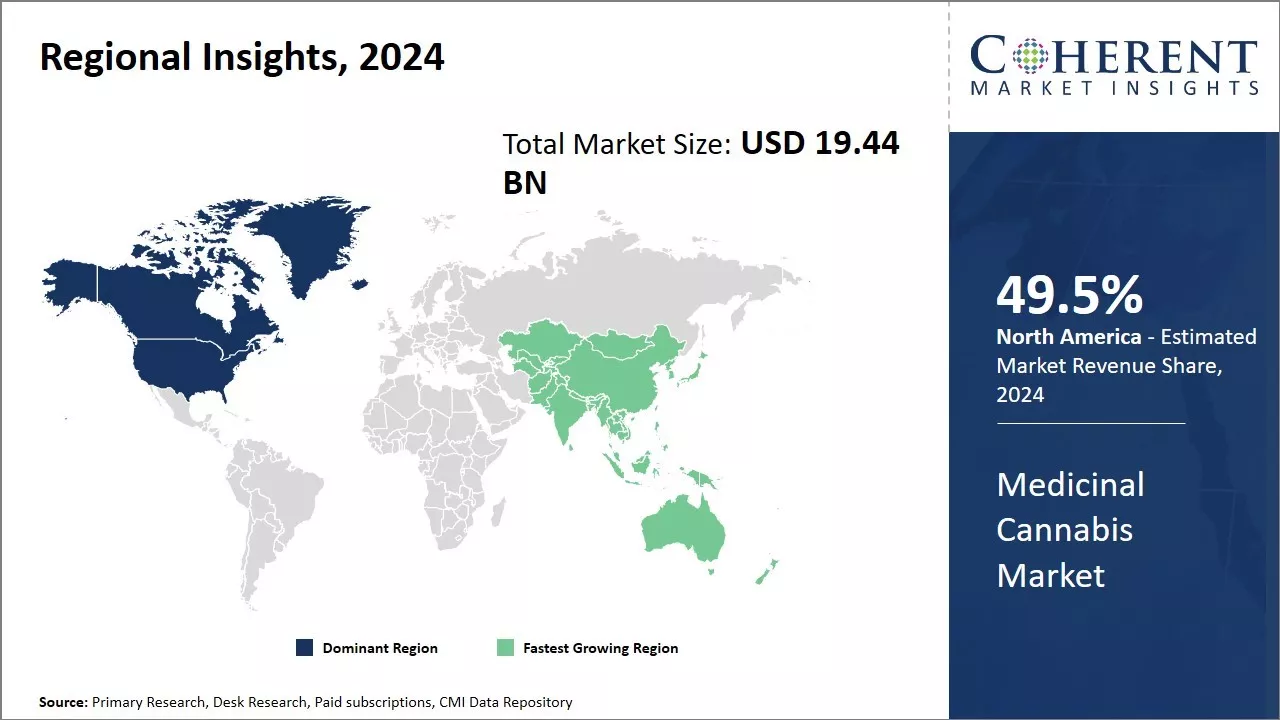
Need a Different Region or Segment? Customize now
North America currently dominates the global medicinal cannabis market, largely due to the growing legalization and acceptance of both medical and recreational cannabis across major markets like the U.S. and Canada. The North America region is anticipated to hold 50.0% of the market share in 2025. Countries in the region have enacted favorable regulations allowing cultivation and distribution of cannabis for medical use over the past decade. This has encouraged significant investments by major cannabis corporations, spurring innovations in areas such as new product development, extraction technologies and clinical research on the therapeutic benefits of cannabinoids. Several US states like California have emerged as global leaders in medical cannabis supplies, supported by a strong agricultural base and expertise in horticulture and greenhouse cultivation techniques ideal for large-scale production.
Asia Pacific is poised to be the fastest growing regional market. While medicinal cannabis remains illegal in many Asian nations, interest is rising given its growing acceptance as an alternative treatment for chronic pain and several mental health conditions. Countries like Australia, South Korea, and Thailand have launched pilot medical programs or are reviewing policies to allow regulated access. This is opening up opportunities for companies to introduce cannabinoid products and establish cultivation and processing facilities. Moreover, Asia Pacific’s medical tourism industry could drive future demand as awareness spreads. Compared to North America and Europe, pricing is relatively lower in Asia Pacific due to differences in regulatory frameworks and tax policies across the region. This makes cannabis accessible as a new therapeutic option for more patients.
Medicinal Cannabis Market Report Coverage
| Report Coverage | Details | ||
|---|---|---|---|
| Base Year: | 2024 | Market Size in 2025: | USD 23.93 Bn |
| Historical Data for: | 2020 To 2024 | Forecast Period: | 2025 To 2032 |
| Forecast Period 2025 to 2032 CAGR: | 23.1% | 2032 Value Projection: | USD 102.58 Bn |
| Geographies covered: |
|
||
| Segments covered: |
|
||
| Companies covered: |
BOL Pharma, Tilray, Medreleaf Corporation, Aurora Cannabis Inc., Canopy Growth Corporation, Insys Therapeutics Inc., Aphria Inc., MGC Pharmaceuticals Limited, GW Pharmaceuticals plc., Medical Marijuana Inc, Enveric Biosciences, Pascal Biosciences, Realize Therapeutics, Celadon Pharmaceuticals Plc., MAK Scientific LLC, MIRA Pharmaceuticals, and Cardiol Therapeutics |
||
| Growth Drivers: |
|
||
| Restraints & Challenges: |
|
||
Uncover macros and micros vetted on 75+ parameters: Get instant access to report
*Definition: The medicinal cannabis market involves the growing, manufacturing, and distribution of cannabis products for medical purposes. This market provides medicinal cannabis treatments to patients through licensed dispensaries and pharmacies. Some key products in this market include cannabidiol oils, medical marijuana, and other cannabis-based medicines that are prescribed to help reduce symptoms of conditions such as chronic pain, epilepsy, nausea, and mental health issues. The goal of this market is to research and develop safe and effective cannabis-based therapies.
Share
Share
About Author
Ghanshyam Shrivastava - With over 20 years of experience in the management consulting and research, Ghanshyam Shrivastava serves as a Principal Consultant, bringing extensive expertise in biologics and biosimilars. His primary expertise lies in areas such as market entry and expansion strategy, competitive intelligence, and strategic transformation across diversified portfolio of various drugs used for different therapeutic category and APIs. He excels at identifying key challenges faced by clients and providing robust solutions to enhance their strategic decision-making capabilities. His comprehensive understanding of the market ensures valuable contributions to research reports and business decisions.
Ghanshyam is a sought-after speaker at industry conferences and contributes to various publications on pharma industry.
Missing comfort of reading report in your local language? Find your preferred language :
Transform your Strategy with Exclusive Trending Reports :
Frequently Asked Questions
Joining thousands of companies around the world committed to making the Excellent Business Solutions.
View All Our Clients
US Reciprocal Tax Impact Analysis On Medicinal Cannabis Market
Stay updated on tariff changes with expert insights and timely information